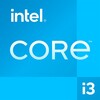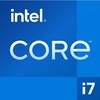Intel Core i3-1220P vs Intel Core i7-1370P
Intel Core i3-1220P
► remove from comparison
The Intel Core i3-1220P is a lower mid-range Alder Lake family SoC designed for use in ultra-light, ultra-thin laptops of the more affordable flavour. It was announced in early 2022 and it has 2 performance cores as opposed to the 6 cores of the top-of-the-line i7-1280P (P-cores, Golden Cove architecture) mated to 8 efficient cores (E-cores, Gracemont architecture). The i3's P-cores are Hyper-Threading-enabled for a total of 12 threads when combined with its E-cores. The clock speeds range from 1.5 GHz to 4.4 GHz for the performance cluster and 1.1 GHz to 3.3 GHz for the efficient cluster. The shortcomings of this processor as compared with the faster Core i5-1240P are many, including the significantly slower iGPU, lower CPU core count, lower clock speeds, complete lack of the vPro features.
Architecture
The i3 is a continuation of Intel's efforts to use the ARM-developed big.LITTLE technology for its own benefit. A single "little" Alder Lake core is supposed to be as fast as a Skylake core (as found in the venerable Core i7-6700HQ among other options) which is six years old at this point. All of Core i3-1220P's CPU cores enjoy access to 12 MB of L3 cache. The integrated memory controller supports various memory types up to LPDDR5-5200, DDR5-4800, LPDDR4x-4267 or DDR4-3200; Intel suggests using no more than 64 GB of RAM, for reference. Just like the other 12th Gen Intel Core processors, this Core i3 comes with the Thread Director which is a new functionality designed to help Windows 11 decide which cores to use for what workload for best performance and efficiency possible. Hardware acceleration of AI algorithms is supported via GNA 3.0 and DL Boost (via AVX2). PCI-Express 5.0 support has not found its way into Alder Lake P processors, so users will have to be content with PCI-Express 4.0 for the time being. Four PCI-Express 4 lanes allow for a read/write rate of up to 7.9 GB/s, provided a suitably fast NVMe SSD is used.
Please note that this is not a user-replaceable CPU. It gets soldered permanently on to the motherboard (FCBGA1744 socket interface).
Performance
While we have not tested a single system built around the 1220P as of October 2023, we have tested a laptop featuring the i5-1240U, a chip with nearly the same specs (2 P-cores mated to 8 E-cores, all running at the same clock speeds as what the 1220P has). Based on that, we expect the 1220P to be just slightly ahead of the Core i5-11400H, the Core i7-1265U and also the Ryzen 5 5600U, as far as multi-thread benchmark scores are concerned. Your mileage may vary depending on how high the CPU power limits are and how competent the cooling solution of your system is.
Graphics
The built-in graphics adapter in the form of the 64 EU UHD Graphics running at up to 1.1 GHz is a slightly downgraded 80 EU Iris Xe. The latter can be found in many Alder Lake-P and Tiger Lake-UP3 processors, like a Core i5-1250P or a Core i5-1145G7, respectively. Despite the lower EU cluster count, this is still a fairly capable iGPU, loaded with modern features such as the AV1 video decoding capability and SUHD 4320p monitor support. The UHD Graphics will happily drive up to 4 monitors simultaneously, provided the laptop has the outputs required. Its gaming performance is unlikely to please the crowds, though, as it will be good for resolutions no higher than 1600x900 and Low settings only in most titles trleased in 2021 and 2022. Your mileage may vary depending on how high the Power Limits are and how capable the cooling solution of a laptop is. Fast RAM is a prerequisite for decent performance as well (the UHD Graphics has to make do with no dedicated video memory).
Power consumption
The i3's base power consumption (also known as the default TDP or Power Limit 1) is 28 W; its "minimum assured" power consumption sits at 20 W. In the meantime, the maximum Turbo power consumption (also known as the PL2) is not supposed to exceed 64 W.
This 12th generation Intel chip is built with Intel's fourth-gen 10 nm process marketed as Intel 7 for decent, as of late 2022, energy efficiency. Expect the i3 to be significantly less power-hungry (and a lot easier to cool) than all other Alder Lake-P chips because of its lower core count.
Intel Core i7-1370P
► remove from comparison
The Intel Core i7-1370P is the flagship Alder Lake-P CPU, which is to say, an expensive 28 W part meant for use in ultra-light (yet actively cooled) laptops. This CPU will probably be announced in early 2023 and it has 6 performance cores (P-cores, Golden Cove architecture) mated to 8 efficient cores (E-cores, Gracemont architecture) according to a leak on Geekbench. The P-cores are Hyper-Threading-enabled for whopping 20 threads when combined with the E-cores. The clock speeds can reach up to 5.2 GHz for the performance cluster (1.9 GHz base speed) and 1.4 GHz to 3.9 GHz for the efficiency cluster. The CPU is quite similar to the older Core i7-1280P but probably offers higher clock speeds.
Full vPro feature set is supported by this Core i7 ("Enterprise" tier, allowing for remote device management).
Architecture
The i7 is a continuation of Intel's efforts to use the ARM-developed big.LITTLE technology for its own benefit. A single "little" Alder Lake core is supposed to be just as fast as a Skylake core (as found in the venerable Core i7-6700HQ among other options) which is six years old at this point. All of a Core i7-1280P's CPU cores enjoy access to 24 MB of L3 cache. The integrated memory controller supports up to 64 GB of LPDDR5-5200, DDR5-4800, LPDDR4x-4267 or DDR4-3200 RAM. Just like the other 12th Gen Intel Core processors, Core i7-1280P comes with Thread Director which is a new functionality designed to help Windows 11 decide which cores to use for what workload for best performance and efficiency possible. Hardware acceleration of AI algorithms is supported via GNA 3.0 and DL Boost (via AVX2). PCI-Express 5.0 support has not found its way into Alder Lake P processors, so users will have to be content with PCI-Express 4.0 for the time being. The CPU still only supports PCIe 4.0 x8 for a GPU and two PCIe 4.0 x4 for SSDs.
Please note this is not a user-replaceable CPU. It gets soldered permanently on to the motherboard (BGA1744 socket interface).
Performance
Multi-thread performance is most comparable to AMD Ryzen 9 5900HS, Ryzen 9 PRO 6950HS, Intel Core i9-11980HK. Which is impressive but comes with a catch; long-term performance sustainability will be rather poor unless the Power Limits are very high and the cooling solution is a truly capable one.
Graphics
The built-in graphics adapter in the form of the 96 EU Iris Xe running at up to 1.5 GHz has seen no change from what was built into the 11th Gen Tiger Lake-UP3 processors, like a i7-1165G7, which is hardly a downside as this iGPU is loaded with modern features such as AV1 video decoding capability and SUHD 4320p monitor support.
Power Consumption
The i7's base power consumption (also known as the default TDP value or PL1) is 28 W, with 64 W being its maximum Intel-recommended Turbo power consumption (also known as the PL2). The "Minimum Assured" power consumption is fairly high at 20 watts. All in all, an active cooling solution is nearly a must.
Core i7-1370P is built with Intel's third-gen 10 nm process marketed as Intel 7.
| Model | Intel Core i3-1220P | Intel Core i7-1370P | ||||||||||||||||||||||||||||||||||||||||
| Series | Intel Alder Lake-P | Intel Raptor Lake-P | ||||||||||||||||||||||||||||||||||||||||
| Codename | Alder Lake-P | Raptor Lake-P | ||||||||||||||||||||||||||||||||||||||||
| Series: Raptor Lake-P Raptor Lake-P |
|
| ||||||||||||||||||||||||||||||||||||||||
| Clock | 1100 - 4400 MHz | 1400 - 5200 MHz | ||||||||||||||||||||||||||||||||||||||||
| L1 Cache | 928 KB | 1.2 MB | ||||||||||||||||||||||||||||||||||||||||
| L2 Cache | 9.5 MB | 11.5 MB | ||||||||||||||||||||||||||||||||||||||||
| L3 Cache | 12 MB | 24 MB | ||||||||||||||||||||||||||||||||||||||||
| Cores / Threads | 10 / 12 | 14 / 20 6 x 5.2 GHz Intel Golden Cove P-Core 8 x 3.9 GHz Intel Gracemont E-Core | ||||||||||||||||||||||||||||||||||||||||
| TDP | 28 Watt | 28 Watt | ||||||||||||||||||||||||||||||||||||||||
| Technology | 10 nm | 10 nm | ||||||||||||||||||||||||||||||||||||||||
| max. Temp. | 100 °C | 100 °C | ||||||||||||||||||||||||||||||||||||||||
| Socket | BGA1744 | FCBGA1744 | ||||||||||||||||||||||||||||||||||||||||
| Features | DDR4-3200/LPDDR4x-4266/DDR5-4800/LPDDR5-5200 RAM, PCIe 4, Thread Director, DL Boost, GNA, MMX, SSE, SSE2, SSE3, SSSE3, SSE4.1, SSE4.2, AVX, AVX2, BMI2, ABM, FMA, ADX, SMEP, SMAP, EIST, TM1, TM2, Hyper-Threading, Turbo, SST, AES-NI, RDRAND, RDSEED, SHA | Thread Director | ||||||||||||||||||||||||||||||||||||||||
| iGPU | Intel UHD Graphics 64EUs (Alder Lake 12th Gen) ( - 1100 MHz) | Intel Iris Xe Graphics G7 96EUs ( - 1500 MHz) | ||||||||||||||||||||||||||||||||||||||||
| Architecture | x86 | x86 | ||||||||||||||||||||||||||||||||||||||||
| Announced | ||||||||||||||||||||||||||||||||||||||||||
| Manufacturer | ark.intel.com | ark.intel.com |


 Deutsch
Deutsch English
English Español
Español Français
Français Italiano
Italiano Nederlands
Nederlands Polski
Polski Português
Português Русский
Русский Türkçe
Türkçe Svenska
Svenska Chinese
Chinese Magyar
Magyar
